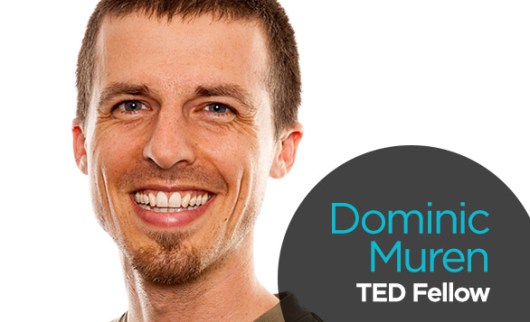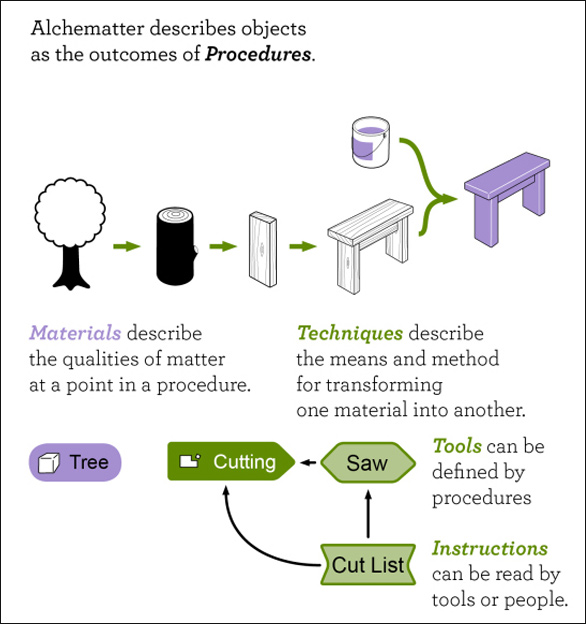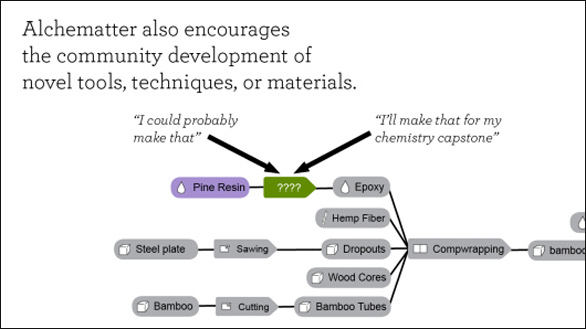
Maker, innovator, and cottage industrialist Dominic Muren wants making to be open, global and modular. He’s just launched his latest project, Alchematter — an online open source platform that breaks down and spells out instructions on how to make, well, anything. He gives us the ins and outs of the site, covering everything from reverse crowdfunding to bricks made of eggshells and pee.
When you first became a Fellow in 2010, you were pretty amped about the concept of skin-skeleton-guts (SSG) manufacturing involving modular electronics — a watch could be modified into a camera, and a camera into a phone, and so on — as well as local production. You wanted to make invention on a small scale possible again.
My design lab the Humblefactory began with this idea of how could I actually be a manufacturer, because it would be fun to make stuff. And then it grew into, “How might I, as an outspoken individual, help this small-scale manufacturing movement grow?” SSG is a design framework that I am still exploring. I’m actually working on putting together a little travel laptop netbook that’s human powered.
But I’m not as single-mindedly focused on electronics anymore. Right now, the main project coming out of Humblefactory is Alchematter.org — a platform that allows makers to share open-source designs for objects. What makes it different from Thingiverse, Instructables and such sites is that what you share on Alchematter is a whole procedure for the creation of objects. Those procedures are defined in a very modular way — which allows them to be really easily remixed or adapted or searched for.
For example, Thingiverse is excellent for describing things 3D printed from plastic or things laser cut, but they basically have to be monolithic, one-off objects. It was meant for: “Here’s a 3D printed part. You want to print this part? Great.”
But what if you wanted to share a procedure for creating, say, a woven piece of cloth? Thingiverse doesn’t have a lot of functionality for instructions. You can write whatever you want, but it doesn’t tell you “Here is the pattern for the cloth, and here is the procedure for using a loom.” Those things — the pattern you follow and the procedure for the loom — are two separate pieces. If you separate those, which Alchematter does, then anytime you want to weave something, you can use the technique for the loom and all you have to switch is the pattern.
Give me an example of something I might want to go to Alchematter for.
Let’s say that you are Peter Haas or one of the other Fellows that has a non-profit that makes a thing, that wants that thing to get massively distributed. The global maker community is a cool way to do that. If you can tell them how to make the thing, then they can just make the thing. You don’t have to spend time replicating it and shipping it, and so on.
The problem with that is the raw materials and the skills and the tools and everything that are available in any one locality are very different from one another. How could you know how to adapt a technique for making a stove, for example?
Let’s say that your non-profit had successfully launched stoves in Rwanda, and you decided, “This is great, we’re going to do it for Bolivia also.” Those are two different places, and it will cost you a lot of money to do the on-the-ground research or partner with an organization. Alchematter lets makers share information about what they’re capable of in Bolivia, building up a knowledge base of what materials are available, what tools are available, even what makers are available — in other words, who are the people who have made projects that look like your stove? And then you can just get on it and say, awesome, here are some of the ways we could tweak it. Here are some of the people we need to get in touch with. These are the materials we might use.
So you’re offering instructions from one place and allowing people with resources, tools, and materials in another place to adapt them.
Yes. The fundamental idea is to separate the description of the object from the restrictions imposed by reality — either because of skills, tools or materials — and to allow much more easy adaptation of designs for things to your local situation.
Another cool thing is that Alchematter modularizes stuff. Again, let’s think about the stove. Let’s say that, in most places, those stoves tend to be made from some kind of factory brick. Let’s say that you wanted to make these stoves in a place that had very low fuel availability, and you wanted to make some kind of method for making a fireproof refractory, so that you didn’t have to fire it — or maybe you had to use a lot less fuel than normal, which would lower the price of the stove.
But this is tricky. How do you do that? There are some methods — for example, there’s this woman who makes bricks out of bacteria and urea, of all things. You can basically pee in a jug, feed it to this bacteria, and its adds urease, an enzyme that breaks down the urea, using that energy to precipitate a calcium ion out of a solution. This makes a marble-like substance.

Out of pee?
Out of pee. It has to be calcium-rich pee, but you could still do that. You could grind up some eggshells with some vinegar that you could make locally using whatever sugar you had. And then you get a bunch of pee. If you put those two solutions together on sand, you get a solid because the calcium sticks the sand together. It’s a ceramic — there’s no glue.
This is the kind of thing that Dow Chemical or Raytheon or somebody develops, but not people in their garages. But Alchematter breaks that fundamental innovation out. You can still define a hypothetical product that uses this pee bacteria thing, and you can say, “Hey, I saw this research that somebody did. I would like to have it adapted to stoves. Here’s the procedure for the stove and here’s the stove I could make if I had this thing and this hypothetical material. I will pay this X bounty for this description.” And then somebody else can come in and say, “Oh, I would pay X bounty,” or “I would pay twice that bounty. My organization can use that too,’ because the thing will be open once it’s shared.
Essentially, you can crowdfund in reverse: instead of a smart person with an idea coming to the community and saying, “Hey, I know how to do this thing. Pay me for it,” you can have someone with a need come to the community and say, “I want this thing pretty bad. Make it for me.” And other people who need it can chip in. So it’s a different model.
How would they know they had a need before the solution was presented?
Since Alchematter is built around these modular procedures, it’s fairly straightforward for a designer to make, say, a table with a marble top. Another maker could pick that procedure up, and make a copy with a hypothetical material in place of the marble — a sort of placeholder, with certain specifications defined. Again, they only know what their limitations are, what skills, materials, costs, levels of energy, or tools do they have access to. So they can pitch in as much as they know, and then rely on the rest of the community to fill in the blanks. In the case above, some other maker might create a new derivative procedure which fills in the marble material with the pee rock from Professor Dosier. That’s how makers help each other be smarter than the sum of their parts.
Where’s all the data coming from, and who’s feeding the information into the system? And who breaks down all the information into modular chunks?
We’re targeting hackerspaces, mostly because they do the biggest variety of making. At least in the beginning, this site will look like Thingiverse or Instructables. But when you define a procedure, the platform asks you very clearly: What are the components that are going into this? What’s the technique that transforms them? Defining an entire procedure from scratch is actually a significant amount of work. This is not just like uploading a 3D file and writing a really short description.
But because it’s modular most of the procedures that get made will ultimately actually be remixes of existing pieces. So for example, let’s say that you wanted to make a wood table. You could literally take an existing table and just go into one part which shows the cut list dimensions and change some of the dimensions, or you might add a piece in the assembly drawings that adds a drawer. You append things onto this existing table rather than doing the whole thing from scratch.

But the maker who wants to upload an object is in charge of breaking it out into modular pieces that are going to be understood? That’s a lot of work. Do you provide guidelines?
This is a stepwise, scaffolded process that makes it easy and can distribute the labor. We’re like Wikipedia. Let’s say that you want to define “Barack Obama,” and in order to do that you have to define what a US president is, and in order to do that you have to define what the US is, and that gets complicated. But you can make a stub, and somebody else can improve a procedure by adding what’s missing. And we can encourage people to help flesh out broken pieces of procedures using game mechanics kinds of things — like you get badges or points. Alchematter is just a tool that lives online and has a community that organically participates and grows around it.
We might also offer contests to encourage participation. A competition to make the best stove would encourage a hundred stove design entries. Only one of them wins, but we get a hundred procedures that flesh out the site.
Or there could be a contest asking: “What could you do with pee and eggshells?” It’s really meant to be a cross-disciplinary experience. We want to give undergraduates in mechanical engineering and chemistry and electrical engineering an opportunity to a Capstone project that actually matters rather than a fake startup that you know will never go anywhere. I was part of that machine. The engineering and sciences in undergrad create a lot of work that is unvalued, never given a chance to be used. Alchematter gives such ideas a chance to become a real, practical resource.
How do you ensure safety and quality?
We are actually in the process of figuring out how to deal with liability for users and liability for the community as a whole. Within the method of description, it asks you a number of times, “Enumerate the dangers of this process.” Once you have those things checked, it can do a rating of procedures and it can this is this difficult and dangerous, this is less difficult and dangerous. We also will have a terms of use that basically outlines what is appropriate for the community. It will be very specific. And we will have a community standards review process.
What are the components of the site?
The main two pieces would be that you have a procedure editing facility, searching and editing facility. You can browse as a non-user, but as soon as you want to make something you’ve got to be on the system, because we need to know where that thing came from and how you did it. So you can search for something, browse through, pick up bits and pieces either by taking a procedure and saying, “I want to start with that and I want to make some adjustments,” and that will copy it into your editing space. You can also learn techniques for materials or tools. So in your editing space you have these pallettes of commonly used materials and commonly used techniques and that sort of thing. This chain of nodes combines and combines until you get to one final thing until you get to the point where you find what you want to make.
The site is GUI based. You can also upload photographs, and we encourage videos. But it does have to be scaffolded within that structure: just having one giant video is not the best way. Instruction needs to be modular.
All of the stuff on Alchematter will be on a viral license, a “you have to share and share alike” license. So if you use this thing and you want to share it, then you need to share it in some way, you need to show the whole thing. We would hope that people would be excited to contribute back, but really we’re much more interested in getting to the point where somebody makes the thing from the site. That’s number one. And thing number two is somebody contributes something back to the site.
Dominic Muren on why electronics recycling is stupid, filmed at TEDGlobal 2010.
Do you cater to any kind of maker? Chemists, woodworkers, cooks, knitters?
That’s the most important piece. The coolest things that happen in making happen because you get experts in various domains interacting. You smush them together and end up with something that’s actually new — something that actually never would have happened before.
Whenever I talk about this, everybody immediately says, “Oh, yeah. And the wealthy people in the West would totally be able to give all their knowledge to those people in the developing world.” To me, that misses the point: most of the knowledge that people in the developed West for making stuff is crappy because it requires huge infrastructure and a lot of capital investment and a lot of space. Much of the manufacturing technologies that are being used in the very informal developing world – even the more formalized developed developing world – are smaller-scale tools and small shops and raw materials that actually come from farms rather than coming from Dow Chemical.
I want to catch that information, number one, before globalization of the economy succeeds and wipes them out; or, number two, before shit hits the fan — this massively centralized, industrialized economy runs on oil and it runs on a stable climate — and Dow goes out of business and we don’t have any raw materials. There’s so much good knowledge that is out there that is in danger of dying, either by success or by failure. Both of them are going to kill it.
I’m hopeful that through efforts like Alchematter will be able to capture enough of the knowledge that exists as well as generate new knowledge that doesn’t exist yet that will help us to more gracefully make the continuing transition. It’s going to be all transitions from here on out. We’ve never had stasis. I don’t know if we’ve ever had stasis, but we want to be more graceful in our transition and more resilient in our response.
I also want Alchematter to be an active exchange between art and science. I intend to see, artists who work with science — such as Fellows Kate Nichols or Suzanne Lee — come on the site and learn how to do scientific procedures in order to serve the arts. And I intend to see scientists doing stuff in order to serve the arts rather than only to serve biotech startups because they pay you a lot of money. That’s not the only reason that you should be excited to be a scientist.
How will you get to far-flung places that don’t have the digital reach?
The maker community is quite well distributed around the world. We also have some exciting partners in the Maker community. TED Fellow Marcin Jakubowski is working with us with Open Source Ecology, Fellow Catarina Mota with Smart Materials, and PopTech Fellow Amy Sun, who runs FabFolk, the social organization that is aligned with fab labs.
This is a powerful community to start with, but we recognize that there will be parts of society that we’ll never be able to reach through a rich web content application. We already are thinking about how are we going to deal with using SMS, or how are we are gisting this stuff so that it can be made into a PDF, or printed on paper. The exciting thing is, because we are modularizing these pieces, it’s easy to omit stuff or restructure this data so that it can fit into a different viewing format, and fit into bit-sized chunks. We know that that is a crucial piece, and we want to capture that information. I want to know how the Maasai make everything. I want to know how the Yanomami make everything. I don’t know how to get to those guys. They don’t even have cell phones. We may have to send Fellows out to gather that information at some point.
Comments (3)
Pingback: American Steroids Online
Pingback: Break it down and make it: Fellows Friday with Dominic Muren | TEDFellows Blog